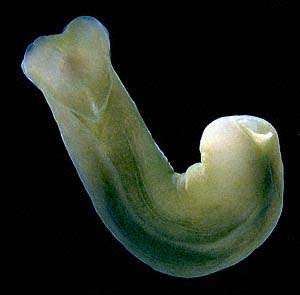
Phanerophthalmus smaragdinus
(Ruppell & Leuckart, 1828)
Order: CEPHALASPIDEA
Family: Smaragdinellidae
DISTRIBUTION
Tropical Indo-West Pacific.
PHOTO
Noumea, New Caledonia, Oct, 1988. 25mm long alive. PHOTO: Bill Rudman.
Phanerophthalmus has a remarkable resemblance to an aglajid, and until quite recently was considered to be a member of that family. The headshield is proportionally very small and the posterior shield and enclosed mantle cavity is an equally small remnant at the posterior end of the body (on the right in the photo). The round opening that can be seen at the posterior end is in fact the "exhalant siphon" from the mantle cavity. The small plate-like shell is partially enclosed in the mantle tissue.
Despite looking like an aglajid from the outside, a quick look at the gut shows that this animal is a herbivore closely related to Haminoea, with a similar radula and gizzard, with three grinding chitinous plates.
Reference:
• Rudman,W.B., 1972. The herbivorous opisthobranch genera Phanerophthalmus A.Adams and Smaragdinella A.Adams. Journal of Natural History, 5: 647-675.
Rudman, W.B., 1998 (December 18) Phanerophthalmus smaragdinus (Ruppell & Leuckart, 1828). [In] Sea Slug Forum. Australian Museum, Sydney. Available from http://www.seaslugforum.net/factsheet/phansmar
Related messages
-
Colour variation in Phanerophthalmus from Reunion.
From: Hugues Flodrops, October 12, 2007 -
Another grass bed find from the Philippines
From: Charles Raabe, July 10, 2006 -
Phanerophthalmus smaragdinus from Reunion Island
From: Philibert Bidgrain, February 23, 2006 -
Phanerophthalmus from Japan
From: Atsushi Ono, November 1, 1999
